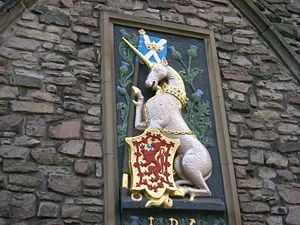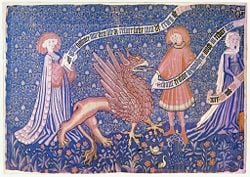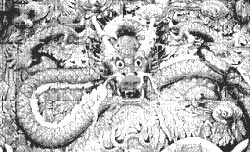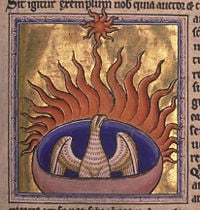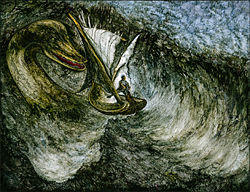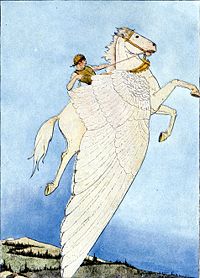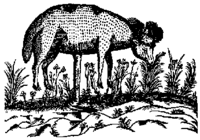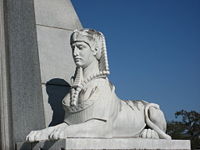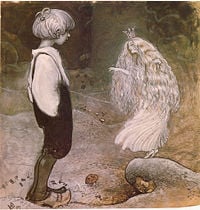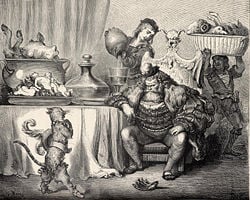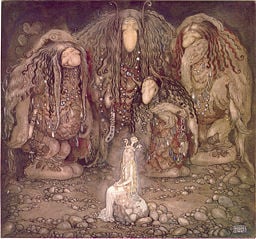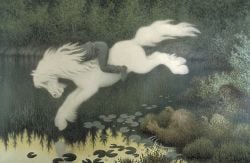Mythical creature
A mystical, mythical, or legendary creature is a creature from mythology or folklore (often known as "fabulous creatures" in historical literature). Examples of legendary creatures can be found in medieval bestiaries. Many mythical creatures have supernatural powers (some good, some evil), powers that even in contemporary times have no physical explanation. In these cases the creatures bear more similarity to spiritual beings, such as angels, in religious thought. Often legendary creatures came to symbolize vices or virtues, or the power of good or evil. In many cases, their actual existence was secondary to the moral of the tale in which they featured.
Legendary creatures have often been incorporated into heraldry and architectural decoration. This is particularly the case with those symbolizing great strength or other power. In contemporary times, many legendary creatures appear prominently in fantasy fiction. These creatures are often claimed to have supernatural powers or knowledge or to guard some object of great value.
Mythical creatures have been part of human culture throughout the ages and across all parts of the world. They are not just the "talking" creatures, animals able to communicate using language and also rather clever, as in Aesop's fables. Mythical creatures are in themselves beyond normal reality, often composites of existing animals or animals and humans.
Some of these creatures may have existed in the past, and many believers have produced fossils and other evidence for their previous existence. Some, such as the Loch Ness Monster or Sasquatch, continue to be "sighted" and sought to this day. While the origins of these fabulous creatures are varied, and often disputed, they have played significant roles in human society. They have been educational, helped parents to discipline their children and to inculcate cultural values and norms, and have served to stimulate the imagination and desire that is ingrained in human nature to experience more than this physical world. Whether they truly exist in physical form is indeed secondary to their existence in the minds of so many people throughout the world and through history.
Origins
Some mythical creatures â such as the dragon or the unicorn â have their origin in traditional mythology and were at one time believed to be real creatures. Greek mythology, for example, features many creatures connected to the godsâharpies were beasts sent by Zeus to exact punishment. In mythology and folklore the world over "wonder beasts" can be found representing the powers of good and evil, the virtues and vices of human nature, and the temptations into which human beings fall. Often incorporated into stories for children, "fairy tales" and the like, these "fabulous creatures" were more real in what they represented than in their physical form.
Others were based on real creatures, originating in garbled accounts of travelers' tales; such as the Vegetable Lamb of Tartary, which supposedly grew tethered to the earth (and was actually a type of fern).
Conversely, some creatures downplayed as just storytelling, have been rediscovered and found to be real in recent times, such as the giant squid.
Mythical creatures are often chimeras, composed of parts of two or more animals. Some of these are the combination of a human being and one or more other creatures. For example, a centaur is a combination of a man and horse, a minotaur of a man and bull. It should be noted that these were not always intended to be understood as literal juxtapositions of parts from disparate species. Lacking a common morphological vocabulary, classical and medieval scholars and travelers would attempt to describe unusual animals by comparing them point-for-point with familiar: the giraffe, for example, was called cameleopard, and thought of as a creature half-camel, and half-leopard. In other cases, the beast was merely an exaggeration that made for exciting story-telling of adventures from far-off lands.
Many mythical creatures have supernatural powers (some good, some evil), powers that even in contemporary times have no physical explanation. In these cases the creatures bear more similarity to spiritual beings, such as angels, in religious thought.
Cryptozoology
Cryptozoology (from Greek: ÎșÏÏ ÏÏÏÏ, kryptĂłs, "hidden"; Î¶áż·ÎżÎœ, zĂŽon, "animal"; and λÏγοÏ, logos, "knowledge" or "study" â c.f. zoology) is the search for animals believed to exist, but for which conclusive evidence is missing. Among these are included some of the legendary creatures. The field also includes the search for known animals believed to be extinct. While cryptozoologists strive for legitimacy â some of them are respected scientists in other fields â and discoveries of previously unknown animals are often subject to great attention, however, cryptozoology has not been fully embraced by the scientific community.
Most criticism from the scientific mainstream is directed at proponents for the existence of the more famous "cryptids" (like Bigfoot, the Yeti, and the Loch Ness Monster), whose existence remain unproven, despite numerous purported sightings, and is considered highly unlikely by scientists, biologists, and zoologists alike. In fact, many of the sightings of such creatures were found to be hoaxes, which further discredits cryptozoology.
Types
There are many types of mythical creatures, following are the main divisions with some examples of each.
Birds and serpents
- Basilisk
- Most often depicted as a reptile, the basilisk is reputed to be king of serpents. One of the most feared of all mythological beasts, a basilisk is said to have the power to cause death with a single glance. In this aspect it bears similarity to the Gorgons of Greek mythology.
- Chinese dragon
- Also appearing in other East Asian cultures, it is also sometimes called the Oriental (or Eastern) dragon. The Chinese dragon is easily recognizable for its long serpentine body that is generally wingless, and its anthropomorphic face, complete with beard. The oriental dragon is generally considered a supernatural or spiritual symbol of heavenly power.
- Dragon
- Typically depicted as a large and powerful Serpent or other reptile it has magical or spiritual qualities, the most famous being the ability to breathe fire from their mouths. More often than not dragons were considered malevolent, associated with evil supernatural forces and the natural enemy of humanity.
- Feng-huang
- Sometimes called the Chinese Phoenix, the feng-huang is a symbol of summer and spiritual balance, and along with the dragon, qilin and tortoise, is one of the most high revered creatures in Chinese tradition. Its appearance is said to indicate some great event, or to bear testimony to the greatness of a ruler. It is often viewed as the sacred union of male and female, Feng being male and Huang female, but also the Feng-Huang can be regarded as a female entity in relation with the male dragon.
- Firebird
- In Slavic folklore, the Firebird is a magical glowing bird from a faraway land. Usually described as a large bird with majestic plumage that glows brightly emitting red, orange, and yellow light, the Firebird is both a blessing and a bringer of doom to its captor. The feathers of the Firebird continue glowing when removed, and are able to provide light for a large room. Thus, the Firebird is much prized and often the object of a difficult quest in fairy tales.
- Phoenix
- Characterized as a bird with brightly colored plumage, after a long life the phoenix dies in a fire of its own making only to rise again from the ashes.
- Ziz
- A giant bird in Jewish mythology, the ziz is the counterpart in the air of the Behemoth (giant creature of land) and Leviathan (giant creature of water). The Ziz is said to be large enough to be able to block out the sun with its wingspan.
Lake monsters
Lake monster or loch monster is the name given to large unknown animals which have purportedly been sighted in, and/or are believed to dwell in freshwaters, although their existence has never been confirmed scientifically. They are generally believed not to exist by conventional zoology and allied sciences, and are principally the subject of investigations by followers of cryptozoology. Sightings are often similar to some sea monsters.
Of these, Nessie of Loch Ness is almost certainly the most famous, and is promoted heavily in the area's tourist industry.
Other well known lake monsters include:
- Champ of Lake Champlain in North America
- Bessie of Lake Erie in the United States
- Chessie of Chesapeake Bay in the United States
- Ogopogo of Lake Okanagan in Canada
- Nahuelito of Nahuel Huapi Lake in Argentina
- Lake Tianchi Monster of Heaven Lake (known as Tianchi (ć€©æ± ) in Chinese and Chonji (ìČì§) in Korean) on the border of China and North Korea
- Isshii of Lake Ikeda in Japan
- Brosno dragon of Lake Brosno in Russia
- Mokele-mbembe of the Congo River in Congo
Monstrous creatures
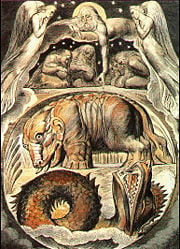
- Behemoth
- Behemoth is the primal unconquerable monster of the land, as Leviathan is the primal monster of the waters of the sea and Ziz the primordial monster of the sky. There is a legend that the Leviathan and the Behemoth shall hold a battle at the end of the world. The two will finally kill each other, and the surviving men will feast on their meat.
- Leviathan
- Leviathan is a Biblical sea monster, referred to in sections of the Old Testament. It is regarded as the monster of the waters, while the Behemoth and the Ziz are regarded as monsters of the earth and the air, respectively.
Chimeras and hybrids
In Greek mythology, the Chimera is a monstrous creature that was composed of several different animals. Other hybrids exist as combinations of human beings with animals and/or birds, as well as a variety of humanoid creatures.
Animals
- Catoblepas
- The catoblepas is a legendary creature from Ethiopia, described first by Pliny the Elder and later by Claudius Aelianus. Its head is always pointing downwards, hence its name which means "to look downwards" in Greek. The creature is said to have the head of a hog and the body of a buffalo with scales on its back. Its stare or breath could either turn people into stone, or kill them. The catoblepas is often thought to be based on real-life encounters with wildebeest.
- Griffin
- The griffin has the body of a lion and the head and wings of an eagle. Seen as guardians of secretly buried wealth, the griffin evolved from a ferocious animal of antiquity to become a symbol of strength and valor.
- Hippogriff
- A Hippogriff is a chimeric legendary creature, supposedly the offspring of a griffin and a horse, specifically a male griffin and a mare (female horse).
- Pegasus
- Pegasus is the famous winged horse of Greek mythology. Riding on Pegasus Bellerophon was able to defeat the chimera. However, Bellerophon tried to fly to Mount Olympus, the realm of the Gods, on Pegasus' back. Pegasus threw Bellerophon from his back for such blasphemous behavior, and was awarded his own place in Mount Olympus.
- Unicorn
- The unicorn, usually depicted with the body of a horse, but with a singleâusually spiralâhorn growing out of its forehead, is one of the most revered mythical beasts of all time. Appearing in numerous cultures, the unicorn has come to be a symbol of purity and beauty, and is one of the few mythical creatures not associated with violence, danger, and fear.
- Vegetable Lamb of Tartary
- The Vegetable Lamb of Tartary (Agnus scythicus or Planta Tartarica Barometz) is a mythical plant of central Asia, believed to grow sheep as its fruit. The sheep were connected to the plant by an umbilical cord and grazed the land around the plant. When all the grazing material was gone, both the plant and sheep died. In the medieval period, the plant was said to explain the existence of cotton.
Part-human
- Adlet
- The Adlet (or Erqigdlet) in the Inuit mythology are a race of fabulous creatures with dogs' legs and human bodies. The lower part of the body is like that of a dog, the upper part is like a man's. Inuit in Labrador and Hudson Bay also use this term to refer to inland native American tribes, but the Inuit from Greenland and Baffin Land, who have no such neighbors, regard Adlet as part-human part-dog.
- Centaur
- In Greek mythology, the centaurs are a race of mythical creatures that are half human and half horse. They are depicted as the head and torso of a man with his waist joined to the horse's withers, where the horse's neck would be.
- Faun
- In Greek and Roman mythology fauns are forest spirits that may help or hinder humans. They are half human - half goat, human from the head to the waist, apart from the addition of goat's horns, and with the lower body of a goat. They are often associated with the Greek god Pan and satyrs.
- Gorgon
- In Greek mythology, the Gorgons were three vicious female mythical creatures that lived on an island and possessed the ability to turn a person to stone by looking at them. They possessed both beautiful and hideous traits, the most famous being their head of coiled snakes instead of hair. Of the three, Medusa is perhaps the most famous of the Gorgons, being the only one of the three who was mortal. She, like many such creatures, met her doom at the hands of a hero aided by the gods.
- Harpy
- Harpies in Greek mythology were winged-beasts that were sent down by Zeus to punish, most famously the prophet Phineus. Like many other second-tier Greek creatures, the Harpies were more prominent in art works than in mythological literature, and while they may occasionally be used in popular culture today, they are most widely remembered for their part in the legendary adventures of Jason and the Argonauts.
- Manticore
- The manticore of Central Asia is a kind of chimera, that is sometimes said to be related to the Sphinx. It was often feared as being violent and feral, but it was not until the manticore was incorporated into European mythology during the Middle Ages that it came to be regarded as an omen of evil.
- Mermaid
- (mer is the French word meaning "sea.") A mermaid is an aquatic creature with the head and torso of human female and a fish-like tail. The male version of a mermaid is known as a "merman," and the gender-neutral plural is merfolk or merpeople. Merfolk appear in a plethora of cultures worldwideâlegends often tell of mermaids singing to sailors, enchanting them, and luring them to their death.
- Minotaur
- In Greek mythology, the Minotaur was part man and part bull. It was kept by King Minos of Crete in the center of a "labyrinth," an elaborate maze-like construction designed by the architect Daedalus specifically to hold the Minotaur. According to legend, the Minotaur required human sacrifices on a regular basis. Theseus volunteered to be sacrificed, and with the help of Daedalus, was able to slay the Minotaur and escape the maze.
- Siren
- In Greek mythology the Sirens were creatures who lived on a remote island surrounded by rocky cliffs. The Sirens lured passing sailors by their singing, which would enchant any sailor listening to the point that he would lose all will-power, and crash his ship upon the Sirens' rocky shore and cliffs, killing all the men aboard.
- Sphinx
- The sphinx has had a long history of secrecy and intrigue, being viewed by many cultures as guardians of knowledge and as speaking in riddles. The sphinx varies in physical features, but is almost always a composite of two or more animals, and some versions are part-human part-animal. Whatever the form, the sphinx embodies paradox, beautiful and alluring, she is also dangerous even deadly; encountering a sphinx is described as confusing and destructive and requires great caution when approaching.
- Tengu
- Tengu ("heavenly dogs") are a class of supernatural creatures found in Japanese folklore, art, theater, literature, and religious mythology. These Japanese spirits were originally thought to take the forms of birds of prey, such that they are traditionally depicted with both human and avian characteristics. In the earliest sources, tengu were actually pictured with beaks, but, in later depictions, these features have often been anthropomorphized into unnaturally long noses. These crafty (oftentimes dangerous) bird-men were long held to be disruptive demons and harbingers of war (much like their Chinese prototypes). Over time, this overtly negative evaluation was softened somewhat, as the Buddhists came to acknowledge the popular conception of these spirits as morally-ambivalent protectors of the mountains and forests, who were as likely to bring windfalls as calamities to humans intruding upon their domains.
Humanoid creatures
- Banshee
- A banshee is one of many spirits of Irish and Scottish folklore. Banshees are omens of death and messengers from the afterlife who would appear and wail under the windows of a house where a person was about to die.
- Brownie
- A brownie is a legendary household spirit popular in folklore around Scotland and Northern England. They are said to inhabit houses and aid in tasks around the house. However, they do not like to be seen and will only work at night, traditionally in exchange for small gifts or food. They usually abandon the house if their gifts are called payments, or if the owners of the house misuse them.
- Dwarf
- A dwarf, appearing most frequently in Norse mythology, is humanoid in form, but short and stocky. They are connected with the Earth and are often said to be miners, engineers, and craftsmen.
- Elf
- The elf is found in Norse mythology and still survives in northern European folklore. Elves can be depicted as youthful-seeming men and women of great beauty living in forests and other natural places, or as small trickster creatures. In early folklore, elves were generally possessed of supernatural abilities, often related to disease, which they could use for good (healing) or ill (sickening) depending on their relationship toward the person they were affecting. They also had some power over time, in that they could entrap human beings with their music and dance. Some elves were small, fairy-like creatures, possibly invisible, whereas others appeared human-sized. Generally they are long-lived, if not immortal.
- Fairy
- A fairy is a spirit or supernatural being, based on the fae of medieval Western European folklore and romance. Sometimes the term is used to describe any mystical creature of humanoid appearance, including goblins or gnomes, and at other times only to describe a specific type of more ethereal creature. Many folktales are told of fairies, and they appear as characters in stories from medieval tales of chivalry, to Victorian fairy tales, and up to the present day in modern literature.
- Gnome
- The gnome is a class of creatures that has taken on many different meanings, but most generally refers to very small people, often men, that live in dark places, especially underground, in the depths of forests, or more recently in gardens. Most European ethnic groups have had some kind of gnome legends with local variations, some helping plants and animals, some helping humans, some reclusive ones staying underground or in dark forests, perhaps hoarding treasure, and others interacting mischievously or even harmfully with humans. Modern traditions portray gnomes as small, old men wearing pointed hats and living in forests and gardens. Despite varying forms, gnomes have the common attribute of being able to move through the earth as easily as humans move atop it.
- Goblin
- The goblin is of Germanic and British folklore, often believed to be the evil or merely mischievous opposite of the more benevolent faeries and spirits of lore. There is no single version of a goblin; the term is more generic for those small creatures that live in dark places and cause trouble, but in more recent years the term has come to refer to creatures that live in caves and terrorize children. Despite local variations, goblins have almost universally been described as troublemakers. They are either simply tricksters and mischievous, like immature children, or actually malevolent, evil-doers, dangerous to human beings.
- Gremlin
- A gremlin is an English folkloric creature, commonly depicted as mischievous and mechanically oriented, with a specific interest in aircraft. Legends concerning gremlins arose from airmen who claimed that failures in their craft were due to sabotage by gremlins.
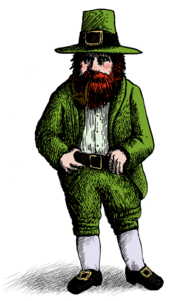
- Leprechaun
- The most famous, recognizable, and misrepresented symbol of Irish mythology is the leprechaun. They have origins stretching back to before the arrival of the Celts. The leprechaun has evolved in popular conception from a species of faerie to an almost cartoonish caricature of Irish culture that can both celebrate and belittle the Irish.
- Nix
- The Nix is the most popular term for the shapeshifting water spirits of Germanic and Nordic folklore. Often times they appear as humans, and are sometimes linked with such similar creatures as the Greek Sirens or the European Mermaids; however, more often than not they are closer to nymphs or sprites in both demeanor and appearance. The Nix may take different forms, but their message is one of warning of impending death by drowning.
- Nymph
- In Greek mythology, a nymph is any member of a large class of female nature entities, either bound to a particular location or land form, such as mountains, groves, springs, rivers, valleys, and cool grottos, or joining the retinue of a god, such as Dionysus, Hermes, or Pan, or a goddess, generally Artemis. Nymphs were the frequent target of lusty satyrs, their male counterpart. Worshipped by the ancient Greeks and said to come from the earth, they were seen to be care givers of the land and life in general. Although not immortal, they lived extremely long lives.
- Ogre
- An ogre is a large and hideous humanoid monster often found in fairy tales and folklore. While commonly depicted as an unintelligent and clumsy enemy, it is dangerous in that it feeds on its human victims. The idea of the ogre has been used as a method of instilling good behavior in children by suggesting that bad behavior attracted and excited ogres, who would then attack, kidnap, or even eat the perpetrator.
- Orc
- Orc refers to various tough and warlike humanoids in various fantasy settings, particularly in the stories of Middle-earth written by J. R. R. Tolkien and derivative fictions. Often barbaric and unintelligent, Orcs are usually seen as the most war-mongering and violent of all mythical creatures.
- Pixie
- Pixies are creatures of English folklore. They are considered to be particularly concentrated in the areas the downs and moors of Devon and Cornwall. Like sprites and other different types of English faeries, pixies are often considered mischievous, but not overtly malevolent creatures of nature. Their most commonly depicted image is a wingless and pointy-eared fairy-esque creature dressed in green.
- Sasquatch
- Sasquatch, colloquially known as "Bigfoot," is a primate-like animal believed to inhabit the forests of North America, although people claim to have sighted the creature in every part of the United States and most of Canada. Akin to the infamous Yeti of the Himalayan Mountains, Sasquatch lore dates back to the earliest Native American tribes.
- Troll
- The troll is of Scandinavian origin but has international popularity in the realms of legend, folklore, and fantasy. One of the most anthropomorphic fantasy creatures, trolls have been depicted in vastly different ways. Generally considered somewhat dangerous, whether through their larger than human size and strength or through more magical means, trolls are recognizably similar to human beings.
- Valkyrie
- In Norse mythology the valkyries are a host of female figures who decide who will die in battle. The valkyries bring their chosen warriors to the afterlife hall of the slain, Valhalla, which is ruled over by the god Odin. There they become the deathless einherjar ("lone fighters") prepared to fight at Odin's side during the eschaton (Ragnarök).
- Vampire
- Vampires are folkloric beings that subsist on the life force of a human being and/or animal. In most cases, vampires are represented as reanimated corpses who feed by draining and consuming the blood of living beings. Bram Stoker's Dracula has arguably been the definitive version of the vampire in popular fiction.
- Werewolf
- A werewolf in folklore is a person who shape-shifts into a Gray Wolf or wolf-like creature, either purposely, by using magic, or after being placed under a curse, often at the time of a full moon. Given that they were a threat to people, tales often focus on methods of revealing werewolves, protecting oneself from them, and killing them.
- Wendigo
- The Wendigo is a malevolent cannibalistic spirit into which humans could transform, or which could possess humans, appearing in Algonquian mythology. Humans who indulged in cannibalism were at particular risk, and the legend appears to reinforce this practice as taboo.
- Yeti
- The yeti, also known as the "Abominable Snowman," is an alleged ape-like animal said to inhabit the Himalayan region of Nepal and Tibet. Most mainstream scientists, explorers, and writers consider current evidence of the yeti's existence to be weak and better explained as a hoax, legend, or misidentification of known species.
Other
- Cerberus
- Cerberus is a multi-headed (usually three-headed) dog. In Greek and Roman mythology it guards the gates of Hades, to prevent those who have crossed the river Styx from ever escaping.
- Chupacabra
- The chupacabra (from the Spanish chupar "to suck" and cabra "goat", literally "goat sucker"), is a legendary cryptid rumored to inhabit parts of the Americas. The name comes from the animal's reported habit of attacking and drinking the blood of livestock, especially goats. It is supposedly a heavy creature, the size of a small bear, with a row of spines reaching from the neck to the base of the tail.
- Kelpie
- The kelpie is a supernatural shape-shifting water horse from Celtic folklore that is believed to haunt the rivers and lochs of Scotland and Ireland. It generally has grayish black fur, and will appear to be a lost pony, but can be identified by its constantly dripping mane. Its skin is like that of a seal but is deathly cold to the touch.
ReferencesISBN links support NWE through referral fees
- Ashman, Malcolm and Joyce Hargreaves. 1997. Fabulous Beasts. Overlook. ISBN 978-0879517793
- Barber, Richard. 2006. Bestiary: Being an English Version of the Bodleian Library, Oxford, MS Bodley 764. Boydell Press. ISBN 978-0851157535
- Borges, Jorge Luis. 2005. The Book of Imaginary Beings. Amazon Remainders. ISBN 0670891800
- Conway, D.J. 2001. Magickal Mystical Creatures: Invite Their Powers Into Your Life. Llewellyn Publications. ISBN 156718149X
- Costello, Peter. 1979. The Magic Zoo: The Natural History of Fabulous Animals. St. Martin's Press. ISBN 0312504217
- Dubois, Pierre, Claudine Sabatier, and Roland Sabatier. 2000. The Great Encyclopedia Of Faeries. Simon & Schuster. ISBN 0684869578
- Eason, Cassandra. 2002. A Complete Guide to Faeries & Magical Beings: Explore the Mystical Realm of the Little People. Boston, MA: Red Wheel/Weiser. ISBN 978-1578632671
- Ellis, Richard. 2006. Monsters of the Sea. The Lyons Press. ISBN 978-1592289677
- Evans-Wentz, W. Y. 2004. The Fairy-Faith in Celtic Countries. New Page Books. ISBN 978-1564147080
- Hassig, Debra. 2000. The Mark of the Beast: The Medieval Bestiary in Art, Life, and Literature. Routledge. ISBN 041592894X
- Keightley, Thomas. 2000. The World Guide to Gnomes, Fairies, Elves & Other Little People. Gramercy. ISBN 0517263130
- Nigg, Joe. 1995. Wonder Beasts: Tales and Lore of the Phoenix, the Griffin, the Unicorn, and the Dragon. Libraries Unlimited. ISBN 156308242X
- Nigg, Joseph. 1999. The Book of Fabulous Beasts: A Treasury of Writings from Ancient Times to the Present. Oxford University Press, USA. ISBN 978-0195095616
- Nigg, Joe. 2001. The Book of Dragons & Other Mythical Beasts. Barron's Educational Series. ISBN 978-0764155109
External links
All links retrieved June 2, 2025.
Credits
New World Encyclopedia writers and editors rewrote and completed the Wikipedia article in accordance with New World Encyclopedia standards. This article abides by terms of the Creative Commons CC-by-sa 3.0 License (CC-by-sa), which may be used and disseminated with proper attribution. Credit is due under the terms of this license that can reference both the New World Encyclopedia contributors and the selfless volunteer contributors of the Wikimedia Foundation. To cite this article click here for a list of acceptable citing formats.The history of earlier contributions by wikipedians is accessible to researchers here:
The history of this article since it was imported to New World Encyclopedia:
Note: Some restrictions may apply to use of individual images which are separately licensed.
